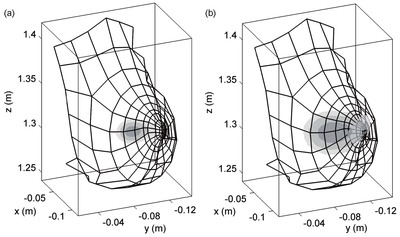|
Active approaches for microwave mammography are based on the dielectric contrast between healthy and malignant tissue. This allows a three-dimensional localization of one or possibly several tumors. Current research activities consider the heterogeneity of breast tissue which is a major challenge for reliable three-dimensional tumor detection. Hence, computationally intensive FDTD-simulations are widely used to study the wave propagation inside the breast. Contrary to these classical modeling strategies, we propose in this paper a flexible and computationally efficient ray tracing environment, where the wave propagation is calculated in heterogeneous dispersive media. Furthermore, we show that conventional delay-and-sum beamforming for ultra-wideband breast cancer detection can fail even in homogeneous tissue. This is due to the fact that no information about the tissue composition is available a-priori. Hence, an incorrect wave velocity might be selected for the image formation. This understanding prompted the development of a novel technique that does not require the wave velocity information. The method considers the times-of-arrival from a triplet of two transmitting and one receiving antenna. This enables the 3D-localization of a tumor even in moderate heterogeneous tissue. |
 |



